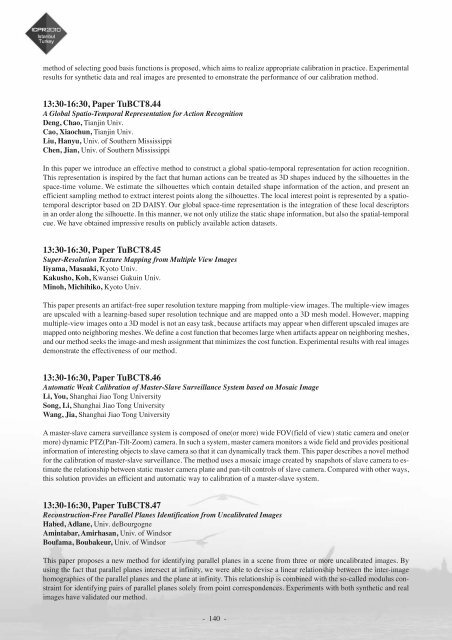Abstract book (pdf) - ICPR 2010
Abstract book (pdf) - ICPR 2010
Abstract book (pdf) - ICPR 2010
- TAGS
- abstract
- icpr
- icpr2010.org
Create successful ePaper yourself
Turn your PDF publications into a flip-book with our unique Google optimized e-Paper software.
method of selecting good basis functions is proposed, which aims to realize appropriate calibration in practice. Experimental<br />
results for synthetic data and real images are presented to emonstrate the performance of our calibration method.<br />
13:30-16:30, Paper TuBCT8.44<br />
A Global Spatio-Temporal Representation for Action Recognition<br />
Deng, Chao, Tianjin Univ.<br />
Cao, Xiaochun, Tianjin Univ.<br />
Liu, Hanyu, Univ. of Southern Mississippi<br />
Chen, Jian, Univ. of Southern Mississippi<br />
In this paper we introduce an effective method to construct a global spatio-temporal representation for action recognition.<br />
This representation is inspired by the fact that human actions can be treated as 3D shapes induced by the silhouettes in the<br />
space-time volume. We estimate the silhouettes which contain detailed shape information of the action, and present an<br />
efficient sampling method to extract interest points along the silhouettes. The local interest point is represented by a spatiotemporal<br />
descriptor based on 2D DAISY. Our global space-time representation is the integration of these local descriptors<br />
in an order along the silhouette. In this manner, we not only utilize the static shape information, but also the spatial-temporal<br />
cue. We have obtained impressive results on publicly available action datasets.<br />
13:30-16:30, Paper TuBCT8.45<br />
Super-Resolution Texture Mapping from Multiple View Images<br />
Iiyama, Masaaki, Kyoto Univ.<br />
Kakusho, Koh, Kwansei Gakuin Univ.<br />
Minoh, Michihiko, Kyoto Univ.<br />
This paper presents an artifact-free super resolution texture mapping from multiple-view images. The multiple-view images<br />
are upscaled with a learning-based super resolution technique and are mapped onto a 3D mesh model. However, mapping<br />
multiple-view images onto a 3D model is not an easy task, because artifacts may appear when different upscaled images are<br />
mapped onto neighboring meshes. We define a cost function that becomes large when artifacts appear on neighboring meshes,<br />
and our method seeks the image-and mesh assignment that minimizes the cost function. Experimental results with real images<br />
demonstrate the effectiveness of our method.<br />
13:30-16:30, Paper TuBCT8.46<br />
Automatic Weak Calibration of Master-Slave Surveillance System based on Mosaic Image<br />
Li, You, Shanghai Jiao Tong University<br />
Song, Li, Shanghai Jiao Tong University<br />
Wang, Jia, Shanghai Jiao Tong University<br />
A master-slave camera surveillance system is composed of one(or more) wide FOV(field of view) static camera and one(or<br />
more) dynamic PTZ(Pan-Tilt-Zoom) camera. In such a system, master camera monitors a wide field and provides positional<br />
information of interesting objects to slave camera so that it can dynamically track them. This paper describes a novel method<br />
for the calibration of master-slave surveillance. The method uses a mosaic image created by snapshots of slave camera to estimate<br />
the relationship between static master camera plane and pan-tilt controls of slave camera. Compared with other ways,<br />
this solution provides an efficient and automatic way to calibration of a master-slave system.<br />
13:30-16:30, Paper TuBCT8.47<br />
Reconstruction-Free Parallel Planes Identification from Uncalibrated Images<br />
Habed, Adlane, Univ. deBourgogne<br />
Amintabar, Amirhasan, Univ. of Windsor<br />
Boufama, Boubakeur, Univ. of Windsor<br />
This paper proposes a new method for identifying parallel planes in a scene from three or more uncalibrated images. By<br />
using the fact that parallel planes intersect at infinity, we were able to devise a linear relationship between the inter-image<br />
homographies of the parallel planes and the plane at infinity. This relationship is combined with the so-called modulus constraint<br />
for identifying pairs of parallel planes solely from point correspondences. Experiments with both synthetic and real<br />
images have validated our method.<br />
- 140 -



